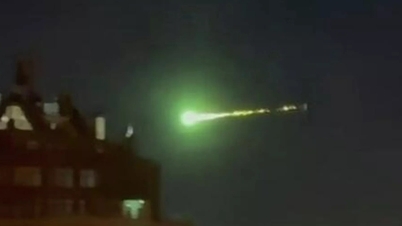 |
| 3I/ATLAS is one of the few comets confirmed to be of interstellar origin. (Source: NASA) |
Comet 3I/ATLAS, estimated to be the size of Manhattan Island (about 21km in length), is approaching the Sun in an astronomical event that has attracted international scientific attention.
Some researchers even believe that the object could be of extraterrestrial origin, as its orbit and movement characteristics are completely different from those of ordinary comets.
On October 30, according to Space , 3I/ATLAS reached perihelion - the time when the comet is closest to the Sun. Although it does not orbit the central star of the Solar System like other comets, 3I/ATLAS's journey creates a loop of approaching and then moving away from the Sun, similar to a visit with no return date.
3I/ATLAS is one of the few comets confirmed to be of interstellar origin, meaning it did not originate in the Solar System, making this year’s close approach an opportunity for astronomers to observe a rare “space visitor.”
Safe distance from Earth
The closest point between 3I/ATLAS and the Sun will be about 130 million miles (more than 209 million kilometers), a position inside the orbit of Mars. The good news is that the comet poses no threat to Earth.
NASA says it will pass within 170 million miles (more than 273 million kilometers) of our planet.
In other words, 3I/ATLAS cannot collide with Earth, and its visit is completely harmless.
Unfortunately, despite its historical significance, the event was not visible from Earth. Since September, the comet has been on the far side of the Sun, obscured by its bright light.
It is not expected to reappear in Earth's skies until November, or even September next year. This means ground-based observatories and satellites in Earth's orbit will miss the comet's perihelion.
Telescopes across the Solar System join the fray
Fortunately, probes and observatories scattered throughout the Solar System have had the opportunity to observe 3I/ATLAS from many unique angles.
Among them: the Mars Fleet, which regularly observes the nearby space environment; NASA's Psyche spacecraft, which is on its way to the metal-rich asteroid Psyche; and Lucy, which is on a mission to study Jupiter's Trojan asteroids.
In particular, the European Space Agency’s (ESA) JUICE spacecraft, which is on a mission to explore Jupiter’s icy moons, is “in an ideal position for observing.” However, because it has to use its main antenna to shield the instrument from solar radiation, JUICE will not be able to transmit its data back to Earth until February next year. A treasure trove of astronomical data is waiting to be deciphered.
Comet or alien probe?
Although most scientists consider 3I/ATLAS to be a normal interstellar comet, Professor Avi Loeb from Harvard University - a famous figure for his controversial research on alien intelligence - has put forward a bolder hypothesis.
Loeb said:
The orbit of a comet has non-gravitational acceleration - that is, it cannot be explained entirely by gravity.
It travels on an unusual path, passing Jupiter, Venus and Mars before approaching the Sun.
The comet has an anti-tail – the jet of material does not fly away from the Sun as usual, but towards the star. This is contrary to the behavior of most comets, whose tails are blown away by the solar wind.
According to Loeb, these characteristics likely demonstrate that 3I/ATLAS is an artificial reconnaissance device launched by an extraterrestrial civilization to collect data about the Solar System, especially about Earth.
During an appearance on The Joe Rogan Experience podcast, Loeb said NASA took a photo of 3I/ATLAS on October 2 with the HiRISE camera on the Mars Reconnaissance Orbiter. He alleged that the photo was not released, implying that NASA was “hiding something.”
According to him, the image could prove that the comet's tail is indeed unusual, contrary to NASA's claim that ATLAS is just a normal comet.
NASA has so far neither confirmed nor denied the existence of the photo. The agency has only affirmed its official stance: 3I/ATLAS poses no danger to Earth and there is no evidence that it is man-made.
Unanswered Questions
The 3I/ATLAS event approaching the Sun opens up a series of fascinating scientific questions:
Do interstellar comets like ATLAS have different structures and compositions than native comets?
Is the reverse tail a sign of a previously undiscovered physical mechanism?
Or is this a chance for humans to come into contact with technology from another civilization for the first time?
Whatever the final conclusion, one thing is certain: 3I/ATLAS makes the world look up at the sky and wonder if we are really alone in the universe.
Source: https://baoquocte.vn/hanh-trinh-cua-sao-choi-3iatlas-gay-nguy-co-gi-cho-trai-dat-333096.html






![[Photo] Chu Noodles - the essence of rice and sunshine](https://vphoto.vietnam.vn/thumb/1200x675/vietnam/resource/IMAGE/2025/11/11/1762846220477_ndo_tl_7-jpg.webp)
![[Photo] Prime Minister Pham Minh Chinh chairs a meeting on housing policy and the real estate market.](https://vphoto.vietnam.vn/thumb/1200x675/vietnam/resource/IMAGE/2025/11/11/1762838719858_dsc-2107-jpg.webp)






























































































![Dong Nai OCOP transition: [Article 3] Linking tourism with OCOP product consumption](https://vphoto.vietnam.vn/thumb/402x226/vietnam/resource/IMAGE/2025/11/10/1762739199309_1324-2740-7_n-162543_981.jpeg)








Comment (0)